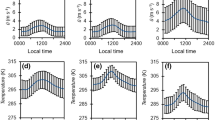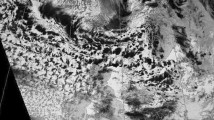Abstract
The Hurst phenomenon is a well-known feature of long-range persistence first observed in hydrological and geophysical time series by E. Hurst in the 1950s. It has also been found in several cases in turbulence time series measured in the wind tunnel, the atmosphere, and in rivers. Here, we conduct a systematic investigation of the value of the Hurst coefficient H in atmospheric surface-layer data, and its impact on the estimation of random errors. We show that usually \(H > 0.5\), which implies the non-existence (in the statistical sense) of the integral time scale. Since the integral time scale is present in the Lumley–Panofsky equation for the estimation of random errors, this has important practical consequences. We estimated H in two principal ways: (1) with an extension of the recently proposed filtering method to estimate the random error (\(H_p\)), and (2) with the classical rescaled range introduced by Hurst (\(H_R\)). Other estimators were tried but were found less able to capture the statistical behaviour of the large scales of turbulence. Using data from three micrometeorological campaigns we found that both first- and second-order turbulence statistics display the Hurst phenomenon. Usually, \(H_R\) is larger than \(H_p\) for the same dataset, raising the question that one, or even both, of these estimators, may be biased. For the relative error, we found that the errors estimated with the approach adopted by us, that we call the relaxed filtering method, and that takes into account the occurrence of the Hurst phenomenon, are larger than both the filtering method and the classical Lumley–Panofsky estimates. Finally, we found that there is no apparent relationship between H and the Obukhov stability parameter. The relative errors, however, do show stability dependence, particularly in the case of the error of the kinematic momentum flux in unstable conditions, and that of the kinematic sensible heat flux in stable conditions.

















Similar content being viewed by others
References
Alvarez-Ramirez J, Alvarez J, Rodriguez E, Fernandez-Anaya G (2008) Time-varying hurst exponent for us stock markets. Physica A 387(24):6159–6169
Andreas EL, Treviño G (1997) Using wavelets to detect trends. J Atmos Ocean Technol 14(3):554–564
Aubinet M, Vesala T, Papale D (2012) Eddy covariance. A practical guide to measurement and data analysis. Springer, Heidelberg
Bendat JS, Piersol AG (2010) Random data, 4th edn. Wiley, New York
Beran J (1989) A test of location for data with slowly decaying serial correlatoins. Biometrika 76(2):261–269
Bernardes M, Dias NL (2010) The alignment of the mean wind and stress vectors in the unstable surface layer. Boundary-Layer Meteorol 134:41–59. https://doi.org/10.1007/s10546-009-9429-8
Bisaglia L, Guégan D (1998) A comparision of techniques of estimation in long-memory processes. Comput Stat Data Anal 27:61–81
Boes DC, Salas JD (1978) Nonstationarity of the mean and the hurst phenomenon. Water Resour Res 14(1):135–143
Box GEP, Jenkins GM, Reinsel GC (1994) Time series analysis forecasting and control. Prentice-Hall, New York
Burlando P, Montanari A, Rosso R (1996) Modelling hydrological data with and without long memory. Meccanica 31:87–101
Caccia DC, Percival D, Cannon MJ, Raymond G, Bassinghtwaighte JB (1997) Analyzing exact fractal time series: evaluating dispersional analysis and rescaled range methods. Physica A 246(3–4):609–632
Cancelli DM, Chamecki M, Dias NL (2014) A large-eddy simulation study of scalar dissimilarity in the convective atmospheric boundary layer. J Atmos Sci 71(1):3–15. https://doi.org/10.1175/JAS-D-13-0113.1
Chamecki M, Dias NL, Salesky ST, Pan Y (2017) Scaling laws for the longitudinal structure function in the atmospheric surface layer. J Atmos Sci 74(4):1127–1147. https://doi.org/10.1175/JAS-D-16-0228.1
Chamoli A, Bansal AR, Dimri V (2007) Wavelet and rescaled range approach for the Hurst coefficient for short and long time series. Comput Geosci 33(1):83–93
Coeurjolly JF (2000) Simulation and identification of the fractional Brownian motion: a bibliographical and comparative study. J Stat Softw 5:7
Crivellaro BL, Dias NL, Chor T (2013) Spectral effects on scalar correlations and fluxes. Am J Environ Eng 3:3–17. https://doi.org/10.5923/j.ajee.20130301.03
Davidson PA, Krogstad P (2014) A universal scaling for low-order structure functions in the log-law region of smooth- and rough-wall boundary layers. J Fluid Mech 752:140–156. https://doi.org/10.1017/jfm.2014.286
de Silva CM, Marusic I, Woodcock JD, Meneveau C (2015) Scaling of second- and higher-order structure functions in turbulent boundary layers. J Fluid Mech 769:654–686. https://doi.org/10.1017/jfm.2015.122
Dias NL (2017) Smoothed spectra, ogives, and error estimates for atmospheric turbulence data. Boundary-Layer Meteorol 166(1):1–29. https://doi.org/10.1007/s10546-017-0293-7
Dias NL, Chamecki M, Kan A, Okawa CMP (2004) A study of spectra, structure and correlation functions and their implication on the stationarity of surface-layer turbulence. Boundary-Layer Meteorol 110:165–189. https://doi.org/10.1023/A:1026067224894
Dias NL, Crivellaro BL, Armani FS, Chor TL, Gobbi MF, Santos AL (2013) Abstract b32a-03. Short-term eddy-covariance measurements of \(\text{CO}_2\) fluxes at Itaipu Lake, Brazil. In: Meeting of the Americas, Cancún, Mexico, May 2013
Garcia C, Jackson P, Garcia M (2006) Confidence intervals in the determination of turbulent parameters. Exp Fluids 40(4):514–522
Gilmore M, Yu C, Rhodes T, Peebles W (2002) Investigation of rescaled range analysis, the Hurst exponent, and long-time correlations in plasma turbulence. Phys Plasma 9(4):1312–1317
Gluhovsky A, Agee E (1994) A definitive approach to turbulence statistical studies in planetary boundary layers. J Atmos Sci 51(12):1682–1690
Grech D, Mazur Z (2004) Can one make any crash prediction in finance using the local hurst exponent idea? Physica A 336(1):133–145
Grech D, Pamuła G (2008) The local hurst exponent of the financial time series in the vicinity of crashes on the polish stock exchange market. Physica A 387(16):4299–4308
Hamed KH (2007) Improved finite-sample Hurst exponent estimates using rescaled range analysis. Water Resour Res 43:1–9
Helland KN, van Atta CW (1978) The ‘Hurst phenomenon’ in grid turbulence. J Fluid Mech 85:573–589
Howell JF, Mahrt L (1997) Multiresolution flux decomposition. Boundary-Layer Meteorol 83:117–137
Hurst HE (1951) Long term storage capacity of reservoirs. Trans ASCE 116:776–808
Katul G, Vidakovic B, Albertson J (2001) Estimating global and local scaling exponents in turbulent flows using discrete wavelet transformations. Phys Fluids 13(1):241–250
Klemes V (1974) The hurst phenomenom: a puzzle? Water Resour Res 10(4):675–688
Kolmogorov AN (1941) The local structure of turbulence in incompressible viscous fluid for very large Reynolds numbers. Proc USSR Acad Sci 30:299–303 (in Russian)
Koutsoyiannis D (2002) The Hurst phenomenon and fractional Gaussian noise made easy. Hydrol Sci J 47(4):573–595
Laushey LM (1951) Discussion of ‘long-term storage capacity of reservoirs’ by H. E. Hurst. Trans ASCE 116:803–804
Lee X, Massman W, Law B (2004) Handbook of micrometeorology. Kluwer Academic Publishers, Dordrecht
Liepmann H (1952) Aspects of the turbulence problem. Z Angew Math Phys 3(5):321–342. https://doi.org/10.1007/BF02008148
Lumley JL, Panofksy HA (1964) The structure of atmospheric turbulence. Interscience, New York
Mandelbrot B (1965) Une classe de processus stochastiques homothétiques á soi; application á la loi climatologique de H. E. Hurst. C R Acad Sci (Paris) 260(1):3274–3277 (in French)
Mandelbrot BB, van Ness JW (1968) Fractional brownian motions, fractional noises and applications. SIAM Rev 10(4):422–437
Mandelbrot BB, Wallis JR (1968) Noah, joseph, and operational hydrology. Water Resour Res 4(5):909–918. https://doi.org/10.1029/WR004i005p00909
Montanari A, Rosso R, Taqqu MS (1997) Fractionally differenced ARIMA models applied to hydrologic time series: identification, estimation and simulation. Water Resour Res 33(5):1035–1044
Montgomery DC, Runger GC (2011) Applied statistics and probability for engineers, 3rd edn. Wiley, New York
Nordin CF, McQuivey RS, Mejia J (1972) Hurst phenomenon in turbulence. Water Resour Res 8(6):1480–1486
Pan Y, Chamecki M, Isard SA (2014) Large-eddy simulation of turbulence and particle dispersion inside the canopy roughness sublayer. J Fluid Mech 753:499–534. https://doi.org/10.1017/jfm.2014.379
Peng CK, Buldyrev SV, Havlin S, Simons M, Stanley HE, Goldberger AL (1994) Mosaic organization of DNA nucleotides. Phys Rev E 49(2):1685–1689
Perry AE, Henbest S, Chong MS (1986) A theoretical and experimental study of wall turbulence. J Fluid Mech 165:163–199
Potter KW (1976) Evidence for nonstationarity as a physical explanation of the Hurst phenomenon. Water Resour Res 12(5):1047–1052
Salesky ST, Chamecki M (2012) Random errors in turbulence measurements in the atmospheric surface layer: implications for Monin–Obukhov similarity theory. J Atmos Sci 69:3700–3714
Salesky ST, Chamecki M, Dias NL (2012) Estimating the random error in eddy-covariance fluxes and other turbulence statistics: the filtering method. Boundary-Layer Meteorol 144:113–135. https://doi.org/10.1007/s10546-012-9710-0
Shi B, Vidakovic B, Katul GG, Albertson JD (2005) Assessing the effects of atmospheric stability on the fine structure of surface layer turbulence using local and global multiscale approaches. Phys Fluids 17(5):055104-1–055104-12
Simonsen I, Hansen A, Nes OM (1998) Determination of the hurst exponent by use of wavelet transforms. Phys Rev E 58(3):2779–2787
Sutton OG (1932) A theory of eddy diffusion in the atmosphere. Proc R Soc Lond A 135:143–165. https://doi.org/10.1098/rspa.1932.0025
Taqqu MS, Teverovsky V, Willinger W (1995) Estimators for long-range dependence: an empirical study. Fractals 3(4):785–798
Taylor GI (1935) Statistical theory of turbulence. Proc R Soc Lond A 151:421–444
UCAR/NCAR-Earth Observing Laboratory (1990) NCAR integrated surface flux system. NCAR/Earth Observing Laboratory, Boulder. https://doi.org/10.5065/D6ZC80XJ
Vandewalle N, Ausloos M (1997) Coherent and random sequences in financial fluctuations. Physica A 246(3–4):454–459
Vergassola M, Benzi R, Biferale L, Pisarenko D (1993) Wavelet analysis of a Gaussian Kolmogorov signal. J Phys A 26(22):6093–6099
Wyngaard JC (1973) On surface-layer turbulence. In: Haugen DA (ed) Workshop on micrometeorology. American Meteorological Society, Boston, pp 101–149
Yaglom AM (1987) Correlation theory of stationary and related random functions I: Basic results. Springer, New York
Yu C, Gilmore M, Peebles W, Rhodes T (2003) Structure function analysis of long-range correlations in plasma turbulence. Phys Plasma 10(7):2772–2779
Zahn E, Chor TL, Dias NL (2016) A simple methodology for quality control of micrometeorological datasets. Am J Environ Eng 6(4A):135–142. https://doi.org/10.5923/s.ajee.201601.20
Acknowledgements
The AHATS data were collected by NCAR’s Integrated Surface Flux Facility. The Itaipu Lake measurements were funded by research Project FUNPAR 2882, with funding provided by CHESF (São Francisco Hydroelectric Company). We thank Tomás Chor for help with data quality control using PyMicra (https://github.com/tomchor/pymicra). We thank Brazil’s CAPES (Coordenação de Aperfeiçoamento de Pessoal de Nível Superior) for B.L. Crivellaro’s Ph.D. Scholarship, and Brazil’s CNPq (Conselho Nacional de Desenvolvimento Científico e Tecnológico) for partial support through Grants and 303581/2013-1 and 401146/2014-6.
Author information
Authors and Affiliations
Corresponding author
Appendices
Appendix 1 The Cases \(q=1\) and \(q=2\)
When \(q=1\), substitution of (14) into (12) yields
for \({\Delta } \gg {\mathscr {T}}_H\). When \(q=2\), substitution of (14) into (12) yields
for \({\Delta } \gg {\mathscr {T}}_H\).
Appendix 2 A Test for Changing Variance
Consider a discretized dataset corresponding to \(30\,\mathrm {min}\) at 20 Hz, with \(N = 36{,}000\) data points \(x_0, x_1, \ldots , x_{N-1}\). A running mean and running variance with window D are defined as
and the ratio of the largest to the smallest \(\widetilde{{ Var}(x)}_{D}(k)\) values over all k is then calculated. The measurement period is rejected when this ratio is larger than r. We used \(D=4800\) and \(r=5\) for u and v, \(D=2400\) and \(r=3\) for w and \(D=2400\) and \(r=4\) for \(\theta \).
Rights and permissions
About this article
Cite this article
Dias, N.L., Crivellaro, B.L. & Chamecki, M. The Hurst Phenomenon in Error Estimates Related to Atmospheric Turbulence. Boundary-Layer Meteorol 168, 387–416 (2018). https://doi.org/10.1007/s10546-018-0353-7
Received:
Accepted:
Published:
Issue Date:
DOI: https://doi.org/10.1007/s10546-018-0353-7




